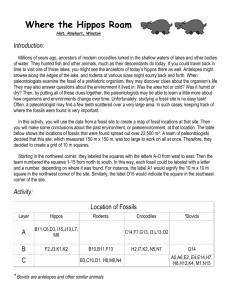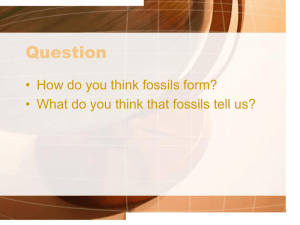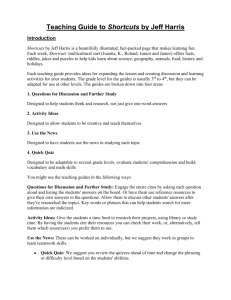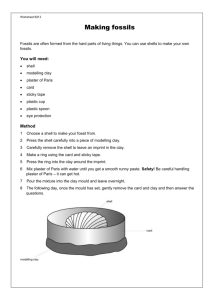MAKE YOUR OWN FOSSILS
advertisement
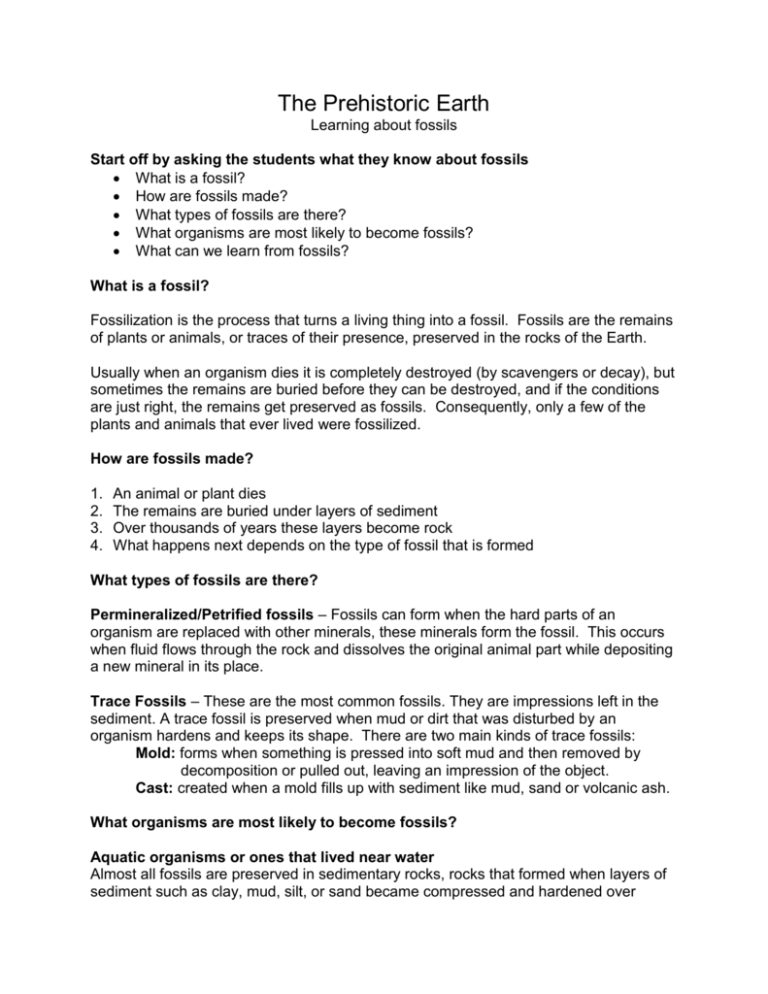
The Prehistoric Earth Learning about fossils Start off by asking the students what they know about fossils What is a fossil? How are fossils made? What types of fossils are there? What organisms are most likely to become fossils? What can we learn from fossils? What is a fossil? Fossilization is the process that turns a living thing into a fossil. Fossils are the remains of plants or animals, or traces of their presence, preserved in the rocks of the Earth. Usually when an organism dies it is completely destroyed (by scavengers or decay), but sometimes the remains are buried before they can be destroyed, and if the conditions are just right, the remains get preserved as fossils. Consequently, only a few of the plants and animals that ever lived were fossilized. How are fossils made? 1. 2. 3. 4. An animal or plant dies The remains are buried under layers of sediment Over thousands of years these layers become rock What happens next depends on the type of fossil that is formed What types of fossils are there? Permineralized/Petrified fossils – Fossils can form when the hard parts of an organism are replaced with other minerals, these minerals form the fossil. This occurs when fluid flows through the rock and dissolves the original animal part while depositing a new mineral in its place. Trace Fossils – These are the most common fossils. They are impressions left in the sediment. A trace fossil is preserved when mud or dirt that was disturbed by an organism hardens and keeps its shape. There are two main kinds of trace fossils: Mold: forms when something is pressed into soft mud and then removed by decomposition or pulled out, leaving an impression of the object. Cast: created when a mold fills up with sediment like mud, sand or volcanic ash. What organisms are most likely to become fossils? Aquatic organisms or ones that lived near water Almost all fossils are preserved in sedimentary rocks, rocks that formed when layers of sediment such as clay, mud, silt, or sand became compressed and hardened over millions of years. These types of sediments are laid down in lakes, swamps and oceans. This is one of the reasons why most fossils are the remains of animals who lived in or near the water. Fossils of land animals/plants are more rare. Usually only the hard parts of an animal, like teeth, bones and shells, become fossilized. Invertebrates Although they do not have bones, many invertebrates have a shell or a hard exoskeleton that can be fossilized. The exoskeleton is like a suit of armour, giving the animal support and protection. Modern invertebrates like lobsters, cockroaches, and spiders have exoskeletons. Ask the students what parts of their body would most likely be preserved as fossils. What can we learn from fossils? Fossils can tell us a lot about what the earth was like when the creature was alive. Permineralized fossils are good at telling scientists how an organism lived and what diseases may have affected it Surrounding fossils may give clues to diet and climate Fossils can be used to date rocks Some species of fossilised organisms lived on the Earth for a very short time. Their fossils will only be found in certain layers and nowhere else. This helps us to know the age of the rock where these fossils are found. Fossils can teach us about evolution and extinct animals By examining fossils scientists can discover how some organisms have changed over time to better suit their environments. Make your own Fossils Purpose: To introduce students to mold and cast fossils by having them create their own trace fossils Materials: Items to create fossils of (twigs, sturdy leaves, ferns, shells, small plastic insects, bones or figures) fossil dough (recipe below) shallow paper cups oil (mineral or vegetable) plaster of paris (and water to mix it with) For the activity leader: large disposable container to mix plaster in (a beaker lined with heavy plastic bags works well) stirring stick (something disposable to mix the plaster) old ladle (to scoop the plaster into the cups) Procedure: 1. have the students label their paper cups with their names 2. press approximately 2 cm of prepared dough into the bottom of each cup (do this beforehand for small kids or to save time). Make sure the surface is very smooth!! 3. lightly coat the object to be fossilized in oil 4. press the object into the clay to make a mold. 5. mix the plaster of paris (adding some salt speeds drying time) 6. quickly cover the clay impressions with approximately 2 cm of plaster 7. leave in a warm place and allow to harden for approximately one hour. 8. carefully peel away the paper cup and remove the plaster cast. DO NOT DISPOSE OF EXCESS PLASTER IN THE SINK, it will permanently clog the drain. Put any excess or waste into the garbage can. Linda’s Fossil Dough Recipe 5 cups flour 2 ½ cup salt ¼ cup cream of tartar (this is sold cheap in the baking section of the bulk food dept.) 5 cups cold coffee 2 cups fairly dry used coffee grounds (if they are really wet reduce the amount of water) 1/3 cup oil Mix all ingredients and cook on medium heat stirring continuously. Continue stirring until the dough is too thick to stir (several minutes). Remove from heat and kneed dough when cool enough to handle. Keep in an airtight container until ready to use.



